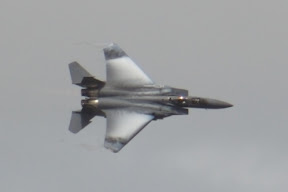
On Saturday, Tracy, who was on vacation in Virginia Beach with her family, called me to say that there was an air show going on at NAS Oceana. I love airplanes, particularly military airplanes, and the noise of fighter jets always excites me. So I checked with David when he got back from work and we decided we'd head over to the show on Sunday. It's a long drive, but I figured it would be worth it.

It was worth it. Aside from the pictures (nearly all of which were taken by Tracy - I looked at the planes through my binoculars), it was just a lot of fun being there. And the noise was great. My only real disappointment in the whole thing was in myself: I forgot to bring suntan lotion and all of us got burned - though David was burned the worst. The weather was odd: cloudy for a few minutes, clear for a few more; it downpoured for about a minute, and then the sun came out. The low ceiling (at times) canceled some events and postponed others. The first jet we saw fly (up close) was the F-15E Strike Eagle. The first picture shows the F-15 with the F-22 Raptor, a P-51 Mustang, and the swept-wing F-86 Sabre. The second shows the F-15 just after takeoff, on full afterburner. I've seen the Eagle fly before: I was at NASA LaRC for a summer, and the pilots from LAFB flew their Eagles overhead nearly every day. It was a great demo: low to the ground with many high-angle-of-attack (AoA) turns; there was so much moisture in the air that nearly every high-AoA maneuver resulted in
 fantastic condensation patterns above the wing (these are examples of Prandtl-Glauert condensation: the extreme pressure drop over the wing surface knocks water vapor out of suspension, causing temporary condensation). That's not white paint on the top of the wing - it's condensation.
fantastic condensation patterns above the wing (these are examples of Prandtl-Glauert condensation: the extreme pressure drop over the wing surface knocks water vapor out of suspension, causing temporary condensation). That's not white paint on the top of the wing - it's condensation.
 But the real draw, for me, was a chance to see the F-22 Raptor fly. Langely AFB didn't yet have the Raptor, when I was there, and it's an amazing machine, both aesthetically and technologically. Where the Eagle impressed me by getting off the runway in 2000 feet, the Raptor floored me by lifting off after just 1000 feet. It barely seemed as though it was moving when the pilot rotated, pulled up the landing gear, and put it into a steep climb. The low ceiling prevented the Raptor from executing any high-altitude maneuvers, but I count that as a Good Thing: it kept the aircraft closer to its spectators.
But the real draw, for me, was a chance to see the F-22 Raptor fly. Langely AFB didn't yet have the Raptor, when I was there, and it's an amazing machine, both aesthetically and technologically. Where the Eagle impressed me by getting off the runway in 2000 feet, the Raptor floored me by lifting off after just 1000 feet. It barely seemed as though it was moving when the pilot rotated, pulled up the landing gear, and put it into a steep climb. The low ceiling prevented the Raptor from executing any high-altitude maneuvers, but I count that as a Good Thing: it kept the aircraft closer to its spectators.
In order maintain its stealthy profile, the Raptor carries its weapons internally: doors open (exposing the weapons to radar detection) just before a weapon is deployed. As part of the demonstration, the pilot banked the aircraft and cycled the weapon bay doors. You can see quite well where the weapons are mounted, in this picture. Here's another beauty shot of the Raptor, you can see (barely) the shockwaves from the afterburner:

 Some of the most extreme edge-of-the envelop, high-AoA flying they demonstrated was by the F/A-18E Super Hornet. Both times they flew it, it had cleared off, so they weren't limited in how high they could fly by the low ceiling of clouds. The most impressive maneuver (to my untrained eye) was a high-speed pass over the landing strip followed by a sudden transition to nearly vertical flight. The noise it made in that maneuver was phenomenal - so was the condensation off the wings. The picture at right gives just a hint of what I mean - we never got a picture of it closer to the ground.
Some of the most extreme edge-of-the envelop, high-AoA flying they demonstrated was by the F/A-18E Super Hornet. Both times they flew it, it had cleared off, so they weren't limited in how high they could fly by the low ceiling of clouds. The most impressive maneuver (to my untrained eye) was a high-speed pass over the landing strip followed by a sudden transition to nearly vertical flight. The noise it made in that maneuver was phenomenal - so was the condensation off the wings. The picture at right gives just a hint of what I mean - we never got a picture of it closer to the ground. The last event was a demonstration by the Blue Angels: impressive formation flying and high-precision maneuvers. They were really pretty, but after seeing some of the very-high-AoA maneuvers we'd seen all day, it was less impressive than it would have been had we only seen the Blue Angels. Still, we got several good photos of the formation flights. Below is one of my favorites.


1 comment:
Good post.
Post a Comment